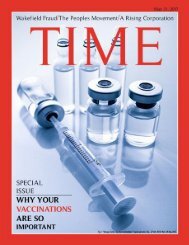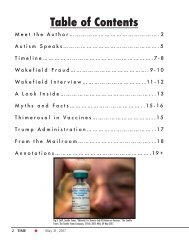JEP fin
You also want an ePaper? Increase the reach of your titles
YUMPU automatically turns print PDFs into web optimized ePapers that Google loves.
Works Cited<br />
Abraham, Anju. “Understanding Vaccines.” PublicHealth. Accessed 14 Mar. 2017.<br />
In this source titled Understanding Vaccines that has a total of 5 subheadings which are about a<br />
vaccine timeline, how they work, what goes into one, CDC recommended vaccines, and myths<br />
debunked. The vaccine timeline starts us off at “Prior to the 15th Century” and then moves us<br />
through century by century, concluding with a future of vaccines. The next subtitle, How Vaccines<br />
Work, talks about how the vaccines train the immune system to recognize and combat<br />
pathogens, and also how they protect an entire population once enough people are immunized.<br />
This section talks about the different kinds of vaccines, as well as different ways to administer<br />
them. The next section titled What Goes Into A Vaccine? looks at the ingredients of vaccines,<br />
which include adjuvants, antibiotics, preservatives, stabilizers, antigens, and lists 6 common<br />
ingredients with a description of their purpose and safety. The CDC-Recommended Vaccinations<br />
section lists the vaccines that are required to enroll in public schools and college, and explains<br />
what each is for and a description of what it is protecting you from. The last section, Vaccine<br />
Myths Debunked, lists 8 common myths and explains why each is false. Some of the myths included<br />
are “Vaccines contain unsafe toxins,” “Vaccines aren’t worth the risk<br />
In comparison with Thimerosal in Vaccines, both confirm that thimerosal has been used as a preservative<br />
in vaccines since the 1930’s, and how it has been removed or reduced from all vaccines<br />
except for the influenza vaccine, and even that has the option to come without the preservative.<br />
They both answer the question of why preservatives are needed in vaccines, and that is to prevent<br />
growth of dangerous bacteria or fungus that would cause contamination. This source offers me<br />
something that the other source did not, a timeline of vaccines in general, the large scale effect of<br />
vaccines, which ones are recommended by the CDC as well as why they are, and it also answers<br />
the common myths that people may believe. Overall, this source is reliable and objective, and the<br />
goal of the source is to educate the reader about the history of vaccines as well as how it works.<br />
This source will fit into the narration section of my research, as it has extensive information on<br />
the history of vaccines, explains how they work, what goes into creating a vaccine and why, vaccines<br />
CDC recommends everyone gets, as well as common vaccine myths. It changed the way I<br />
think about my topic by having a timeline of vaccine progression through the centuries, and also<br />
other common vaccine ingredients that may be a reason for some parents to fear vaccinations.<br />
36 TIME May 31, 2017





